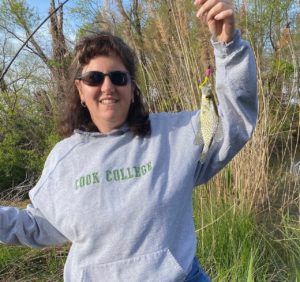- Tomato and pepper transplanting has begun in southern New Jersey. With the on and off again heavy rains we have been getting all growers should consider applying at-transplanting fungicides for root rot control. Please click here to see this article from last week.
- Root rot in pea has been reported. Infected plants will wilt and collapse, especially in wet, low areas of the field. Look for black stem lesions at the base of the plant at the soil line. In general, Pythium infections won’t extend beyond one inch above the soil line in infected plants. Under ideal conditions a white, cottony growth may be present and is a diagnostic feature. In Pythium infected plants, the outer cortex of the root can easily be pulled off. For, more information on damping-off please click here.
- Scouting and controlling Septoria leaf spot in parsley.
- Bacterial leaf spot has been reported on savoy cabbage in southern New Jersey.
- Timber rot has been reported in greenhouse pepper in southern New Jersey. For more information on white mold on tomato and pepper click here.
- Cold weather injury has been reported in numerous vegetable crops throughout the state.
- Bacterial leaf blight in Cilantro was reported in southern New Jersey.
- Common leaf spot was reported in strawberry. For more information click here. Weather conditions have also been ideal for fruit rot infections. For more information on controlling fruit rots in strawberry please click here.
- White rust and anthracnose have been reported in spinach over the past few weeks. For more information click here
- For the updated list of fungicides for use in the control of important diseases in the greenhouse please click here.
- Transplant producers need to remember to vent their structures to reduce relative humidity buildup going into the evenings to help reduce leaf wetness during the overnight.
- The 2020/2021 Commercial Vegetable Production Recommendations Guide is available for free online! With many county offices running reduced hours or being closed this is the easiest way to obtain the newest recommendations.
- For a quick review on managing fungicide resistance development using tank mixes and fungicide rotations, and information on FRAC group 4, FRAC group 7, and FRAC group 3 and FRAC group 11 fungicides please click on hyperlinks.
Vegetable Crops Edition
Seasonal updates and alerts on insects, diseases, and weeds impacting vegetable crops. New Jersey Commercial Vegetable Production Recommendations updates between annual publication issues are included.
Subscriptions are available via EMAIL and RSS.
Quick Links:
 NJ Commercial Vegetable Production Recommendations
NJ Commercial Vegetable Production Recommendations
 Rutgers Weather Forecasting - Meteorological Information important to commercial agriculture.
Rutgers Weather Forecasting - Meteorological Information important to commercial agriculture.
Vegetable Disease Update – 4/30/20
USDA ‘Farmers to Families Food Box Program’ Info Webinar TODAY at 2pm for Farmers, Shippers, Suppliers
The U.S. Department of Agriculture (USDA) Agricultural Marketing Service (AMS) will host a webinar on Wednesday, April 29, 2020, at 2 p.m. ET, for farmers, shippers and other suppliers interested in learning more about the Farmers to Families Food Box Program. This webinar is an opportunity for these parties to learn how to supply produce, dairy and meat products to vendors supplying food boxes to non-profits and other entities feeding hungry Americans.
Register for the Webinar HERE.
Additionally, AMS, the Food and Nutrition Service (FNS) and the Office of Partnerships and Public Engagement (OPPE), published Frequently Asked Questions for non-profit organizations seeking to receive food through the Farmers to Families Food Box Program.
Frequently Asked Questions are answered here.
More information is available on the Farmers to Families Food Box Program webpage.
Additional questions may be submitted to USDAFoodBoxDistributionProgram@usda.gov.
On-Farm Direct Marketing in 2020 Webinars – Every Tuesday Night in May
Rutgers Cooperative Extension Agricultural Agents are hosting a 4-par t webinar series, every Tuesday in May from 7:00-8:00PM to assist farmers with on-farm direct marketing operations to develop strategies for the 2020 season. This 4-part, weekly program will present and discuss the following topics:
t webinar series, every Tuesday in May from 7:00-8:00PM to assist farmers with on-farm direct marketing operations to develop strategies for the 2020 season. This 4-part, weekly program will present and discuss the following topics:
Session 1 (May 5th): Maintaining Social Distancing and Safe Food Handling Practices: Guidance for Farm Markets – Wesley Kline, Ag Agent, RCE of Cumberland Co. and Meredith Melendez, Ag Agent, RCE of Mercer Co.
Session 2 (May 12th): Sales and Distribution Strategies – William Bamka, Ag Agent, RCE of Burlington Co. and Stephen Komar, Ag Agent, RCE of Sussex Co.
Session 3 (May 19th): U-Pick Operation Guidelines under COVID-19 – Meredith Melendez, Ag Agent, RCE of Mercer Co.
Session 4 (May 26th): Farmer Panel – Strategies We Are Using – (Farmers TBD) Moderators: Michelle Infante-Casella, Ag Agent, RCE of Gloucester County and Meredith Melendez, RCE of Mercer Co.
To Participate online for All 4 Events:
Use the link: https://go.rutgers.edu/k0d59m8h
Or join by phone:
+1-650-429-3300 USA Toll
Access code: 226 795 368 # and then # again
We suggest visiting at least 15 minutes before the session start time to confirm system requirements
For more events hosted by Rutgers Cooperative Extension check out the NJAES Events Calendar.
Ask the Ag Agent Weekly Online/Call-In Forum and New Web Page
Ask the Ag Agent was created when COVID-19 forced a new normal in communications nationwide. Rutgers Cooperative Extension Agricultural Agents working with “Ask the Ag Agent” education and outreach are c ommitted to the agriculture industry and all interested in growing plants, raising livestock and essential resources related to agriculture. The program now features a new Ask the Ag Agent website with more information.
ommitted to the agriculture industry and all interested in growing plants, raising livestock and essential resources related to agriculture. The program now features a new Ask the Ag Agent website with more information.
Farmers and others are welcome to join a weekly teleconference each Wednesday night from 7:00pm-8:00pm. Weekly events are hosted by Rutgers Cooperative Extension Agricultural Agents working with the farming industry.
This call-in/WebEx event features updates on farm management, crop conditions, farm industry observations, agricultural agency programs and other topics discussed by farmers, agricultural agents and other agricultural service providers.
Hosted by Bill Bamka, Stephen Komar, Michelle Infante-Casella and Meredith Melendez, this weekly communication provides a forum for discussion for farmers and all involved in NJ agriculture. Agricultural agency personnel, non-profit organizations and others have participated and added additional discussion with farmers.
This event and other events hosted by Rutgers Cooperative Extension can be found on the Rutgers NJAES Events website.
To join the “Ask the Ag Agent” forum each week on a computer/tablet/smartphone via the WebEx Videoconference:
Use the URL: https://go.rutgers.edu/rc9n3kxt
To join the “Ask the Ag Agent” each week on the Phone:
Call: (650)-429-3300
Access Code: 799-743-872 # followed by #
Penn State Webinar: H-2A Agricultural Workers in Times of Uncertainty
Penn State Cooperative Extension is hosting a free webinar to discuss the H-2A program in Pennsylvania. This may be helpful for NJ Farmers to listen in to find any updates or tips on how to handle this agricultural worker program. You must register to join this online event. In order to register you will need to create an account on the Penn State advertisement page.
Webinar Date: Thu., May 7, 2020
(6:30 PM – 8:00 PM ET)
Registration deadline: May 7, 2020
5:30 p.m.
COVID-19 mitigation efforts, including international travel restrictions and consulate closures, have disrupted the normal functioning of the H-2A visa program for temporary workers. These disruptions to the H-2A program raise questions about the timely arrival of guest workers and the impact on essential food and agricultural businesses. The H-2A Agricultural Workers in Times of Uncertainty Webinar will provide answers and guidance to the many questions surrounding this topic.
The dangers of COVID-19 itself similarly raises questions around how to protect the health and well-being of H-2A visa holders. As front-line workers, the protection of their livelihoods and health are integrally tied to the protection of public health.
Penn State Extension will be holding a townhall-style webinar to address these topics, and to provide answers and guidance to these questions. Join us as we hear from a panel of subject matter experts, including Brook Duer, Staff Attorney at the Penn State Center for Agricultural and Shale Law; Grant Meckley, Pennsylvania Keystone Health’s Agricultural Worker Program; Scott Sheely, Executive Director of the Lancaster County Agriculture Council; and Richard Stup, Agricultural Workforce Specialist at Cornell Cooperative Extension. Also joining us will be Alyssa Charney, Agriculture Legislative Assistant from Senator Casey’s Office.
Attendees will have the opportunity to either send in questions ahead of time, or during the webinar itself, for a Q&A session following the panelists’ overview and update on the H-2A visa program.
There is no cost for this webinar, however registration is required to receive the webinar link. To go to the registration page you can also see https://go.rutgers.edu/if9tsm4h.
Dealing with Stress on the Farm During Trying Times
This is a stressful time for many people in our country and especially on the farm. With constant updates from government officials and media sharing new about the pandemic and the fear of the unknown for the future, it is understandable to feel overwhelmed, stressed and anxious. Seeing other farmers around the nation struggling with crop losses and distribution nightmares makes other farmers wonder what is yet to come. You are not alone and there are resources to help if you are struggling with stress and anxiety.
For assistance contact the Substance Abuse and Mental Health Services Administration’s (SAMHSA) Disaster Distress Helpline at 800-985-5990, the National Suicide Prevention Lifeline at 800-273-8255 or text MHFA to 741741 to talk to a Crisis Text Line counselor.
Farmers often feel they may be mentally and physically tougher than most people. That may be true. However, it is understandable if you are feeling depressed or anxious right now, just like the millions of people across the country who are facing the same worries and challenges. It’s perfectly understandable since most people have never experienced times like we are facing now. It’s extremely important to take care of your mental health. Helping yourself means you will be able to help others in the future.
While times may not change as quickly as we would like, there are easy self-care strategies that can help reduce feelings of depression and anxiety, or prevent anxiety before it even starts.
Here are some tips that may help:
1. Eat healthy foods to keep your body in top working order and avoid foods/beverages that cause issues with underlying health conditions.
2. Exercise reduces symptoms of depression and anxiety. Exercise is not the same as regular activity at work. Take a brisk walk or jog down a farm road, ride a bike, lift weights (even if you need to make your own out of what you have around the farm and start light).
3. Practice relaxation therapy. Focusing on tensing and relaxing muscle groups can help you relax voluntarily when feeling overwhelmed, stressed or anxious. Concentrate on the shoulder and neck regions of the body, where stress often builds.
4. Be kind to yourself. Treat yourself with the same compassion you would a friend and allow others to help as you would help them.
5. Stay connected. Even if you can’t get together face-to-face, you can stay connected to friends, family and neighbors with phone calls, text messages, video chats and social media. If you’re feeling lonely, sad or anxious, reach out to your social support networks – all is kept confidential. Share what you are feeling and offer to listen to friends or family members about their feelings. We are all experiencing this scary and unc ertain time together.
ertain time together.
6. Monitor media consumption. While you might want to stay up-to the minute with COVID-19 news, too much exposure can be overwhelming. Balance media consumption with other activities you enjoy, such as playing with pets, reading, cooking, fishing at the farm pond, playing games with family or listening to music.
Adding small changes to your routine each day can make a big difference to your overall mood and well-being. Just remember, if you need help, help is available.
